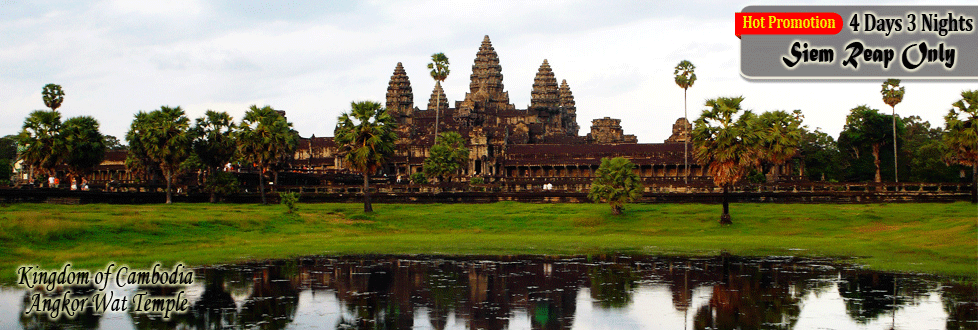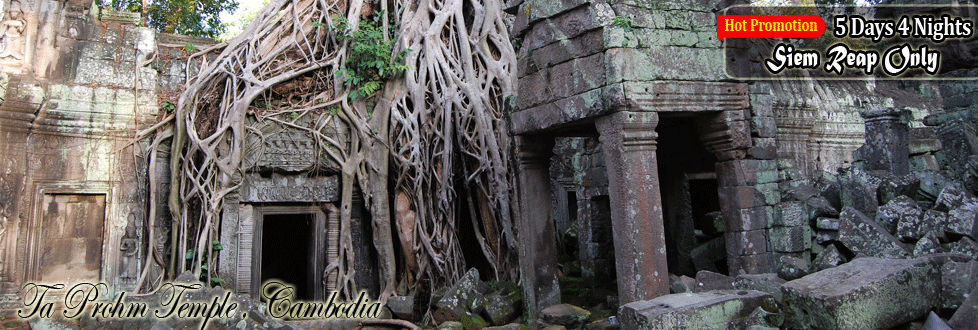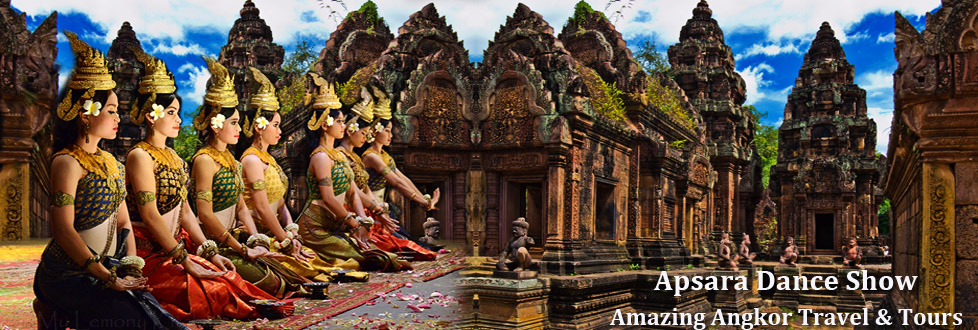|
Cambodia Information
Cambodia Tour Packages
Cambodia Hotels
Cambodia Attraction
|
Cambodia History
The sparse evidence for a Pleistocene human occupation of present day Cambodia are quartz and quartzite pebble tools found in terraces along Mekong River, in Stung Treng and Kratié provinces, and in Kampot Province, but their dating is not reliable. Some slight archaeological evidence shows communities of hunter-gatherers inhabited Cambodia during Holocene: the most ancient Cambodian archeological site is considered to be the cave of Laang Spean, in Battambang Province, which belongs to the so-called Hoabinhian period. Excavations in its lower layers produced a series of radiocarbon dates as of 6000 BC. Upper layers in the same site gave evidence of transition to Neolithic, containing the earliest dated earthenware ceramics in Cambodia Archeological records for the period between Holocene and Iron Age remain equally limited. Other prehistoric sites of somewhat uncertain date are Samrong Sen (not far from ancient capital of Oudong), where first investigations started just in 1877, and Phum Snay, in the northern province of Banteay Meanchey. Prehistoric artifacts are often found during mining activities in Ratanakiri. The most outstanding prehistoric evidence in Cambodia however are probably "circular earthworks", discovered in the red soils near Memot and in adjacent region of Vietnam as of the end of the 1950s. Their function and age are still debated, but some of them possibly date from 2nd millennium BC at least. A pivotal event in Cambodian prehistory was the slow penetration of the first rice farmers from North, which begun in the late 3rd millennium BC. They probably spoke ancestral Mon-Khmer. Iron was worked by about 500 BC. The most part of evidence come from Khorat Plateau, Thai country nowadays. In Cambodia some Iron Age settlement were found beneath Angkorian temples, like Baksei Chamkrong, others were circular earthworks, like Lovea, a few kilometers north-west of Angkor. Burials, much richer, testify improvement of food availability and trade (even on long distances: in the 4th century BC trade relations with India were already opened) and the existence of a social structure and labor organization. Pre-Angkorian and Angkorian polities Dark ages of Cambodia Independence and Vietnam War Between 1969 and 1973, Republic of Vietnam forces and U.S. forces bombed and briefly invaded Cambodia in an effort to disrupt the Viet Cong and Khmer Rouge. Some two million Cambodians were made refugees by the war and fled to Phnom Penh. Estimates of the number of Cambodians killed during the bombing campaigns vary widely, as do views of the effects of the bombing. The US Seventh Air Force argued that the bombing prevented the fall of Phnom Penh in 1973 by killing 16,000 of 25,500 Khmer Rouge fighters besieging the city. However, journalist William Shawcross and Cambodia specialists Milton Osborne, David P. Chandler and Ben Kiernan argued that the bombing drove peasants to join the Khmer Rouge. Cambodia specialist Craig Etcheson argued that the Khmer Rouge "would have won anyway", even without US intervention driving recruitment although the US secretly played a major role behind the leading cause of the Khmer Rouge. Khmer Rouge rule The Khmer Rouge reached Phnom Penh and took power in 1975. The regime, led by Pol Pot, changed the official name of the country to Democratic Kampuchea. They immediately evacuated the cities and sent the entire population on forced marches to rural work projects. They attempted to rebuild the country's agriculture on the model of the 11th century, discarded Western medicine, and destroyed temples, libraries, and anything considered Western. Over a million Cambodians, out of a total population of 8 million, died from executions, overwork, starvation and disease. Estimates as to how many people were killed by the Khmer Rouge regime range from approximately one to three million, with two million (or about one-third of the population) being the most commonly cited figure. This era gave rise to the term Killing Fields, and the prison Tuol Sleng became notorious for its history of mass killing. Hundreds of thousands fled across the border into neighbouring Thailand. The regime disproportionately targeted ethnic minority groups. The Cham Muslims suffered serious purges with as much as half of their population exterminated. In the late 1960s, an estimated 425,000 ethnic Chinese lived in Cambodia, but by 1984, as a result of Khmer Rouge genocide and emigration, only about 61,400 Chinese remained in the country. The professions, such as doctors, lawyers, and teachers, were also targeted. According to Robert D. Kaplan, "eyeglasses were as deadly as the yellow star" as they were seen as a sign of intellectualism. In November 1978, Vietnamese troops invaded Cambodia. The People's Republic of Kampuchea, a Pro-Soviet state led by the Salvation Front, a group of Cambodian leftists dissatisfied with the Khmer Rouge, was established. In 1981, three years after the Vietnamese invasion, the country was divided up between a further three factions that the United Nations euphemistically referred to as the Coalition Government of Democratic Kampuchea. This consisted of the Khmer Rouge, a royalist faction led by Sihanouk, and the Khmer People's National Liberation Front. The Khmer Rouge representative to the United Nations, Thiounn Prasith was retained. Throughout the 1980s the Khmer Rouge, supplied by Thailand, the United States and the United Kingdom continued to control much of the country and attacked territory not under their dominance. These attacks, compounded by total economic sanctions from the United States and its allies, made reconstruction virtually impossible and left the country deeply impoverished. Peace efforts began in Paris in 1989 under the State of Cambodia, culminating two years later in October 1991 in a comprehensive peace settlement. The United Nations was given a mandate to enforce a ceasefire, and deal with refugees and disarmament known as the United Nations Transitional Authority in Cambodia (UNTAC). End of Khmer Rouge rule and transition |




.jpg)
.jpg)
.jpg)

.jpg)
.jpg)
.jpg)

.gif)

 Cambodia Visa & Passport
Cambodia Visa & Passport 



.png)
